Florida / Miami Marlins All-Time Top 40 Players: Part 2

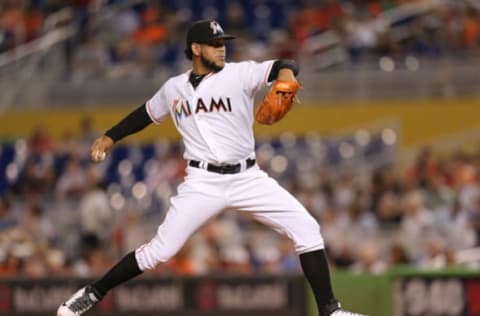
Last Friday, we started a five part series on the Top 50 Florida and Miami Marlins of all time.
To kill some time this offseason, Marlin Maniac is going over the past 27 seasons of MLB history in South Florida. Using the Wins Above Replacement (WAR) metric, we were able to rank the 50 top players in Miami Marlins history. Oh, I know there are other metrics, but I feel as if WAR is the best for comparing players of different positions and eras.
For those of you who missed it, here’s the crib notes version of the countdown so far.
Just Short
60. Sandy Alcantara (3.3)
59. Mark Buehrle (3.5)
58. Emilio Bonifacio (3.5)
57. Moises Alou (3.5)
56. Braden Looper (3.6)
55. Alfredo Amezaga (3.7)
54. Quilvio Veras (3.9)
53. Bryan Harvey (4.0)
52. Starlin Castro (4.0)
51. Chris Volstad (4.2)
Marlins Ranked 50th through 41st
Yesterday, we went in some detail over the players ranked 50th through 41st. This first group of 10 featured three starters, two relievers, two shortstops, a super-utility infielder, a center fielder, and a Hall-of-Fame catcher.
50. Omar Infante (4.3)
49. Livan Hernandez (4.5)
48. Devon White (4.5)
47. Ivan Rodriguez (4.5)
46. Al Leiter (4.8)
45. Derek Dietrich (4.8)
44. Chris Hammond (4.9)
43. Steve Cishek (4.9)
42. Robb Nen (4.9)
41. Edgar Renteria (5.0)
Without further adieu, here’s today’s edition of the All-Time Countdown.
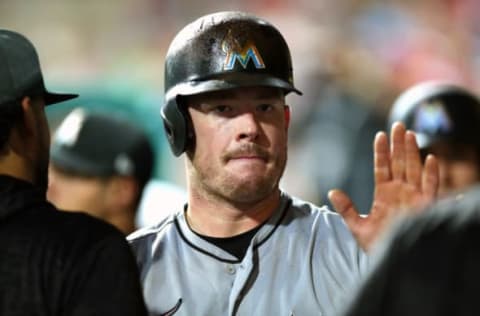
40. Justin Bour (5.0)
Justin Bour is a 6’3″, 265 lb. first baseman from Washington, D.C. Born on May 28th, 1988, he was a 25th round selection of the Chicago Cubs in 2009. This was after he hit 46 round-trippers in division I play with George Mason over three seasons.
Bour made his way up through the Cubbies’ system until 2013, when he appeared in 83 games for the Tennessee Smokies. He was there for a second consecutive season after slashing .283/.360/.455 in 138 games in 2012. He regressed to a .237/.313/.461 in his second season there. The Marlins picked Bour up during the AAA Phase of the Rule V draft following the 2013 season.
Bour played most of the 2014 season with the New Orleans Zephyrs, hitting 18 homers and slashing .306/.372/.517 in 103 games. In 39 games with the Marlins, he hit .284/.361/.365. On September 14th, Bour collected a pinch-hit RBI-single to tie up the Philadelphia Phillies at four before Christian Yelich crossed the plate on a wild pitch to win it.
In 2015, Bour appeared in a career-high 129 Marlins games. He slashed out a .262/.321/.479 line, with 23 home runs and 73 RBI. He also drew 34 walks and struck out 101 times. On July 1st, Bour batted fourth and was one-for-three to start out. In the bottom of the ninth, he hit a three-run, walk-off homer against the San Francisco Giants to earn a 6-5 victory. Bour finished fifth in the NL Rookie of the Year voting.
Bour appeared in 90 games in 2016, missing a substantial chunk of the season due to injury. He put up a .264/.349/.475 slashline with 15 round-trippers and 51 RBI. On April 29th, Bour was three-for-four with a double, two homers, and five RBI in a 6-3 Miami Marlins win over the Milwaukee Brewers.
In 2017, for the fourth year in a row, Bour increased his OPS. He slashed .289/.366/.536 in 108 games, with a career-best 25 home runs and 83 RBI. His OPS at that point had tracked from .726-to-.800-to-.824-to-.902. On April 30th, Bour totaled a career-best six RBI in a 10-3 win against the Pittsburgh Pirates. He was four-for-five with a homer and a double in the contest.
2018 would see Bour collect 19 homers in 112 games for the Miami Marlins. He slashed .227/.347/.412, with a clear regression in power while clearly gaining in patience. He walked 70 times, far-and-away his greatest full-season figure in the simple counting stat. On August 10th, the Marlins traded Bour with cash to the Phillies for minor league pitcher McKenzie Mills.
Bour has since gone 37-for-200 at the major league level between the Phillies and the Los Angeles Angels. He’s since taken his talents to the Far East, with the Hanshin Tigers in Nippon Professional Baseball.
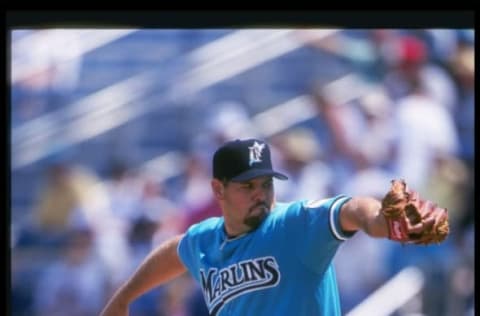
39. Pat Rapp (5.3)
Another “original” Marlin, Pat Rapp was chosen by the Florida Marlins with the 10th pick of the 1992 expansion draft from the San Francisco Giants. He was not a part of the club’s initial Opening Day roster, starting instead with their triple-A affiliate in the Pacific Coast League, the Edmonton Trappers.
A 6’3″, 195 lb. right-handed starter, Rapp was chosen in the 15th round of the 1989 draft by the Giants, and had just started his major league career when taken in the expansion draft. In three appearances for San Francisco, including two starts, Rapp was 0-2 with a 7.20 ERA.
After starting 1993 with the Trappers, Rapp joined the Florida Marlins rotation midseason, and was good for 16 starts. He was 4-6 with a 4.02 ERA and a 1.489 WHIP. His 106 ERA+ indicates that he was better than the league average pitcher. In fact, all four of Florida’s qualified relievers topped the 100 mark, joined by the Rapp as the only starter (Charlie Hough was right on the nose, with an even 100 in the metric).
The strike-shortened 1994 campaign would see Rapp rank second amongst the club starters with a 113 ERA+, along with a 7-8 record in 23 starts and a 3.85 ERA. Never considered a “strikeout artist,” Rapp nevertheless led the 1994 team with 75 K’s.
Going again by ERA+, Rapp posted his signature year in 1995, with a mark of 122, the best from amongst the Florida Marlins starting staff. Second on the team to John Burkett‘s 188 1/3 innings, Rapp tossed 167 1/3 while tying for the team-lead with 14 victories. He was 14-7 with a 3.44 ERA and 102 K’s. Rapp’s 1.398 WHIP was the best mark of his career.
In 1996, Rapp fell off to the tune of an 8-16 mark, with a commensurate 5.10 ERA and an ERA+ of just 80. His 1.694 WHIP was also the worst of his career. After starting the 1997 with a 4-6 record and a 4.77 ERA, the Florida Marlins traded Rapp to the San Francisco Giants for minor leaguers Brandon Leese and Bobby Rector.
Ultimately, Rapp pitched another five seasons in the major leagues, later joining the Kansas City Royals, the Boston Red Sox, the Baltimore Orioles, and the Anaheim Angels before leaving the game at the age of 33.
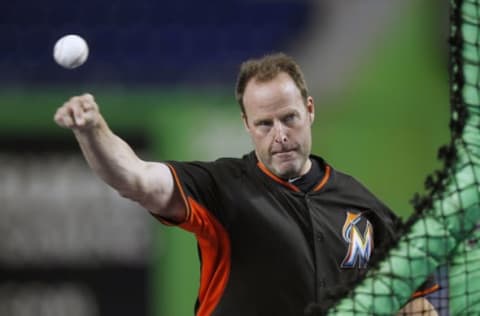
38. Mike Redmond (5.3)
Mike Redmond, was a 6’1″, 185 lb. catcher from Seattle, Washington. Born on May 5th, 1971, he signed with the Florida Marlins in 1992 after going undrafted out of Gonzaga.
Redmond worked his way up through the Marlins system for the next six years, with stops for the Kane County Cougars, the Brevard County Manatees, the Portland Sea Dogs, and the Charlotte Knights. In 1998, he made his major league debut for the Fish, slashing .331/.368/.458 in 37 appearances. His batting average and OBP would have led the club with more at bats, and his SLG was 23 points lower than team-leader Cliff Floyd. Redmond nabbed an NL-second 42.5 percent of runners trying to steal, throwing out 17-of-40.
In 1999, Redmond backstopped in 84 games for the Marlins, slashing .302/.381/.351. In 2000, he racked up an NL second .996 fielding percentage as catcher while slashing .252/.316/.300 in 87 games.
Redmond only played in 48 games in 2001, but slashed a nice figure, with a .312/.376/.426 line. In 2002, Redmond caught 29 runners trying to steal, ranking fifth in the NL despite appearing in only 88 games. His 42 percent CS rate ranked fourth, and his slashline was again impressive, coming in at .305/.372/.387 with 28 RBI.
Redmond’s figures trailed off in the two seasons following, at .251/.311/.332 in 140 games. In the 2003 postseason, he mostly warmed the bench, going 0-for-1 with a walk and a run as the Florida Marlins took home their second World Series Championship.
Later, Redmond played five seasons for the Minnesota Twins and a season with the Cleveland Indians at the age of 39. From 2013 through 2015, he managed the Miami Marlins to a 155-207 record for a winning percentage of .428.
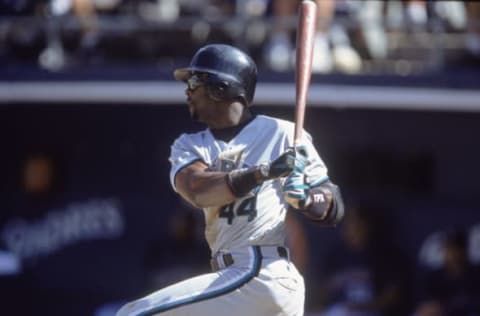
37. Preston Wilson (6.2)
Preston Wilson is a right-handed centerfielder from Bamberg, SC, and a first round pick of the New York Mets in 1992. Six years later, he went six-for-20 in eight games for his major league debut with the Mets. On May 22nd, 1998, they sent him with Geoff Goetz and Ed Yarnall to the Florida Marlins for Mike Piazza. With the parent club in Florida, Wilson was just two-for-38 for the remainder of the campaign.
1999 stands as Wilson’s official “rookie” year, and he made the most of it, finishing second in the National League Rookie of the Year Award vote. In 149 games, he slashed out a .280/.350/.502 line with 26 round-trippers and 71 RBI, along with 11 stolen bases. The lone offensive downfall of Wilson was his 28.7 percent strikeout rate, or 156 whiffs in 543 plate appearances.
Wilson’s slash dipped slightly through his 2K season, with a .264/.331/.486 mark and an NL-high 187 strikeouts. He also set a new career-high with 31 homers and an NL-eighth 121 RBI in a team-high and NL-fourth 161 games. Wilson also ranked sixth in the circuit with 36 stolen bases.
In 2001, Wilson slashed .274/.331/.494 with 23 homers and 71 RBI, along with 20 stolen bases in 123 games for the 76-86 Marlins. 2002 represented a nadir in Wilson’s South Florida career – a .243/.329/.429 slashline along with 23 homers and 65 RBI in 141 games. After the season, the Florida Marlins traded Wilson to the Colorado Rockies with Vic Darensbourg, Charles Johnson, and Pablo Ozuna for Mike Hampton, Juan Pierre, and cash.
Wilson set new career-highs in his first season in Colorado, hitting 36 homers and an NL-leading 141 RBI. His .282 average and .537 slugging percentage were both the best marks of his career. For his efforts, he made the all-star team for the first and only time in his career.
Wilson played another season and a half with the Rockies, and later played for the Washington Nationals, the Houston Astros, and the St. Louis Cardinals.
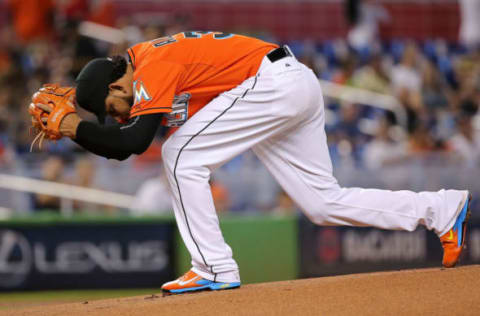
36. Henderson Alvarez (6.3)
Henderson Alvarez, also known as “The Entertainer,” was a 6′, 1″, 205 lb. right-hander from Valencia, VZ. Born on April 18th, 1990, he came up through the Toronto Blue Jays’ minor-league system, beginning in 2007 with the DSL Blue Jays. By 2011, he was ready for major league action.
Alvarez would appear in the Toronto rotation for 10 turns in 2011 and 31 in 2012. Over those 41 games, he was 10-17 with a 4.52 ERA, 119 strikeouts in 251 innings, and a 1.363 WHIP. After the 2012 season, the Blue Jays parted ways with Alvarez via trade. He joined Anthony DeSclafani, Yunel Escobar, Adeiny Hechavarria, Jake Marisnick, Jeff Mathis, and Justin Nicolino in a trade to the Miami Marlins for Jose Reyes, Emilio Bonifacio, John Buck, Josh Johnson, and Mark Buehrle.
Despite ranking sixth on the Miami Marlins with 17 starts in 2013, Alvarez’ 2.3 bbWAR ranked third on the team, behind Jose Fernandez and Giancarlo Stanton. Alvarez was 5-6 with a 3.59 ERA, a 3.18 FIP, a 1.140 WHIP, and 57 whiffs in 102 2/3 innings. In Miami’s last game of the season, on September 29th, Alvarez shutout the Detroit Tigers on a 99-pitch no-hitter. He walked one, struck out four, and hit Prince Fielder with a pitch. The Marlins won it on a walkoff, when Stanton crossed the plate on a Luke Putkonen wild pitch in the bottom of the ninth.
In 2014, Alvarez played his way into his first all-star game. He was 12-7 through the regular season, with a 2.65 ERA and a. 3.58 FIP. He also had a 1.235 WHIP, a career high 111 strikeouts in 187 innings, and an NL leading three complete game shutouts. On April 19th, he struck out four Seattle Mariners in a complete game two-hit shutout, walking nobody and getting 62-of-90 pitches over the plate in a 7-0 road victory. Then on May 6th, he struck out a season-high seven New York Mets in a complete game six-hit 3-0 shutout. Alvarez also ranked third in the NL with 36 assists from the mound.
2015 for Alvarez started out with a whimper, and would see Alvarez lose all four of his starts. He had a 1.567 WHIP after those four losses, allowing 28 hits in 22 1/3 innings while striking out only nine. After right-shoulder inflammation sidelined him twice in the early going, he would spend the remaining campaign on the 60-day DL.
Granted free agency by the Marlins after the 2015 season, Alvarez signed a free-agent deal with the Oakland Athletics for one-year and $4.25 million. He never appeared with the A’s, and only resurfaced with the Philadelphia Phillies for three appearances in 2017. He refused a minor league assignment following the season, and was declared a free agent. He’s currently part of the Washington Nationals minor league system.

35. A.J. Ramos (6.4)
A.J. Ramos is a 5’10” relief pitcher from Lubbock, Texas. The Florida Marlins chose him in the 21st round of the 2009 MLB Amateur Entry Draft.
For the first three seasons of his professional career, Ramos made his way up through the Florida- then Miami Marlins minor league affiliate feeder system. In September, 2012, he got his first look at the major league level with the Marlins, striking out 13 in 9 1/3 innings over 11 games.
Aside from a one-game rehab assignment in 2014, Ramos has not again pitched in the minor leagues. In 2013, he appeared in 68 games for the Marlins, striking out 86 in 80 innings while going 3-4 with a 3.15 ERA.
It was more of the same for Ramos in 2014. Another 68 appearances, along with 73 whiffs in 64 frames. He was 7-0 with a 2.11 ERA, with a 1.234 WHIP and only 5.1 hits surrendered per nine innings of work. Most impressively, Ramos only gave up one home run all season.
Ramos inherited the closer role in 2015 after a wildly inefficient start for Steve Cishek. Cishek saved three games in seven chances through mid-May, and then manager Dan Jennings relieved him with Ramos.
Ramos responded with his signature professional season. He was 2-4 with a 2.30 ERA, along with a career-best 1.009 WHIP in 70 1/3 innings. He also saved his first 32 games and struck out a career-best 87 batters.
Ramos remained the closer in 2016, saving a career-high 40 and striking out 73 in 64 frames. Still, there were warning signs showing that maybe Ramos had lost a little something, even that early on. We only notice now in hindsight, but his WHIP ballooned to 1.359 as he walked 35 for a BB/9 rate of 4.9 – nearly Barraclough-like. Ramos was named to the all-star team that season, the only time he has made it so far. He was 1-4 with a 2.81 ERA.
In 2017, Ramos saved another 20 games for the Marlins, although he closed the Miami part of the season with a 3.99 ERA. At the trade deadline, they sent him to the New York Mets for Merandy Gonzalez and Ricardo Cespedes.
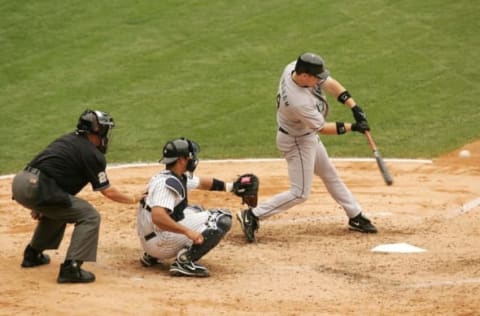
34. Josh Willingham (6.4)
Josh Willingham is a 6-foot-2, 230 lb. right-handed left fielder from Florence, AL. Born on February 17th, 1979, the Florida Marlins chose him in the 17th round of the 2000 MLB Amateur Entry Draft.
Four years later, Willingham made his debut on the big-stage of major league baseball, going five-for-25 in 12 games for Florida. In 2005, he again spent most of the year in the minors, coming up for another “cup of coffee” and going seven-for-23 in a short look.
Willingham didn’t spend years becoming a great baseball player to someday say he went 12-for-48 in the majors. In 2006, he played his first full MLB season for the 78-84 Marlins. In 142 games, he slashed .277/.356/.496 with a team-second-tying (Dan Uggla had 27, Miguel Cabrera had 26) 26 homers and 74 RBI. In the field, Willingham posted a .968 fPct and graded out just a hair below a “league average” outfielder, finishing at -3 DRS in 1069 2/3 innings.
The 2007 Marlins posted a 71-91 record, while Willingham appeared in 144 contests. He hit .254/.364/.470 while driving 21 out of the park and closing with a team-second 89 RBI. He finished the year with a .987 fielding percentage in 1176 1/3 innings in left, and was again below average at -7 DRS.
Willingham improved his defense by leaps-and-bounds in his last season with the Marlins, posting a 1.000 fPCT in 855 1/3 innings with five DRS. Limited by injury to only 102 games, his slashline remained essentially unchanged from his previous season, at .254/.364/.470 with 15 homers and 51 RBI for the 84-77 club.
After the 2008 season, the Marlins traded Wilingham with Scott Olsen to the Washington Nationals for P.J. Dean, Emilio Bonifacio, and Jake Smolinski. After two seasons with the Nats, Willingham played a season for the Oakland Athletics, two-and-a-half for the Minnesota Twins, and half-a-season for the Kansas City Royals.
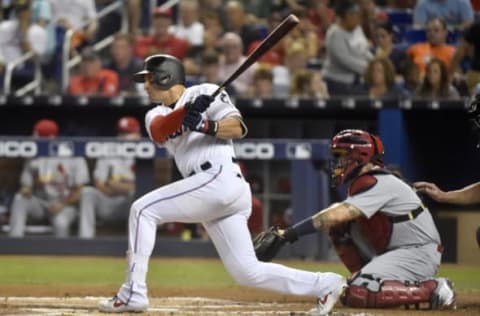
33. Martin Prado (6.5)
Martin Prado completed his fifth and final season with the Marlins in 2019, with a WAR level well below replacement level for the first time in his major league career.
Prado initially joined the Marlins from the New York Yankees after the 2014 postseason, along with David Phelps for Garrett Jones, Nathan Eovaldi, and Domingo German. He had previously played a season-and-a-half with the Arizona Diamondbacks after spending his first seven major league seasons with the Atlanta Braves. He made the all-star team for the only time in his career with the Braves in 2010.
When Prado joined the Marlins, he was already 31-years-old, but Miami was trusting him to produce. Miami owed him five years and $62 million, of which the Yankees picked up $6 million.
Prado’s first season in Miami was his best since 2012, as evidenced by his 3.3 WAR for the year. He appeared in 129 games, hitting .288/.338/.394, with nine round-trippers and a team-third 63 RBI. He also had yet to lose a step defensively, saving nine defensive runs above average in 1034 innings at the hot corner. Prado also played 11 games at second base.
2016 would be even better for the Venezuelan native, the last time the Marlins were really in contention for most of the season. He posted a 3.9 WAR, the third highest figure of his career, while hitting .305/.359/.417. He clubbed eight homers with a team-third 75 RBI, and continued to hold down third base. Defensively, he took a step back, but was still considered league average by coming out even on DRS.
After that, Prado spent his next two seasons struggling to stay healthy, and only appeared in a combined 91 contests between 2017 and 2018. He was still above replacement level in each of the two seasons despite his limited playing time, but only half a win, combined.
In 2019, Prado returned to appear in 104 games, but he wasn’t quite carrying the same lumber as he had in seasons’ past. He slashed just .233/.265/.294 and finished up at -1.3 WAR. Despite his offensive struggles, Prado continued to man third base at right around league average.
Following the 2019 season, Prado was granted free agency. It’s unclear where he’ll end up, but if I was on the Marlins ownership committee, I’d float the idea of keeping him on in a coaching role.
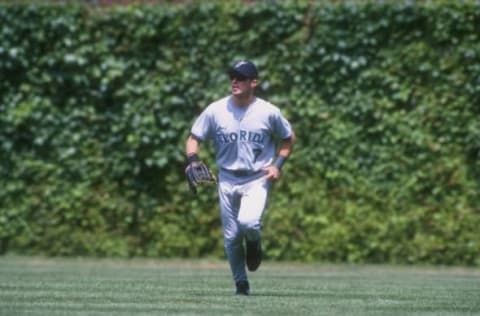
32. Mark Kotsay (6.8)
Mark Kotsay was a 6-foot, 190 lb. left-handed batting and throwing outfielder from Whittier, CA. Born on December 5th, 1975, Florida chose him in the first round of the 1996 MLB Amateur Entry Draft with the ninth overall selection.
Kotsay made extremely quick work of the Marlins minor league system, making his major league debut in 1997 after time with the Kane County Cougars (Single-A, Midwest League) and the Portland Sea Dogs (Double-A, Eastern League). In his first major league look, he went 10-for-52 in 14 games.
In 1998, Kotsay played in a career-high 154 contests, and slashed .279/.318/.403 with 11 homers and 68 RBI. He also stole 10 bases, and was 25 defensive runs saved above average in 1227 2/3 innings in the outfield. Unfortunately, Florida finished with a still-franchise worst 54-108 record, just a season after winning their first World Series Championship.
The Marlins were 12 games better in 1999, finishing at 66-96, while Kotsay maintained his slash line at .271/.306/.402 with eight home runs and 50 RBI. He had 19 outfield assists in 986 innings, along with a .981 fielding percentage and 14 DRS.
In 2000, Kotsay took another step forward in terms of his offensive development, hitting .298/.347/.442 in 152 games. He clubbed another 12 round-trippers with 57 RBI and a career-high 19 stolen bases. As always, he was an asset in the outfield, with nine more DRS a .990 fPCT, and 14 assists in 1107 1/3 innings.
Kotsay remained with the Marlins through most of 2001 Spring Training, then was traded to the San Diego Padres with Cesar Crespo for Omar Ortiz, Matt Clement, & Eric Owens.
After three seasons with the Padres, Kotsay played four years with the Oakland Athletics, a half-season with the Atlanta Braves, two half-seasons for the Boston Red Sox, a season-and-a-half with the Chicago White Sox, a season each with the Milwaukee Brewers, and two years back with the Padres again. He’s currently the Quality Control Coach for the A’s.
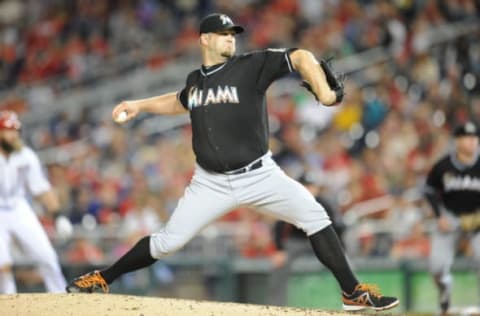
31. Brad Penny (7.5)
Brad Penny was a 6-foot-4, 200 lb. right-handed starter from Blackwell, OK. Born on May 24th, 1978, the Arizona Diamondbacks chose him in the fifth round of the 1996 MLB Amateur Entry Draft.
In 1999, Penny, still a minor leaguer, was traded by Arizona with Abraham Nunez and Vladimir Nunez to Florida for Matt Mantei. He made his major league debut for the 2000 Marlins, going 8-7 with a 4.81 ERA over 23 appearances, including 22 starts. In 119 2/3 innings, he struck out 80 and closed the campaign with a less-than-adequate 1.504 WHIP for the 79-82 club.
Penny was over a full run better per-game with a 3.69 ERA in 2001. He went 10-10 over 31 starts, with 154 K’s in 205 innings, a much-improved 1.156 WHIP, and a 115 ERA+, up from 92 the season prior. Despite his improvement, the Marlins finished at 76-86.
In 2002, Penny again went 8-7 while his ERA regressed to 4.66 and his WHIP increased back to 1.531. He whiffed 93 in 129 1/3 innings, starting 24 games in total. The Marlins finished at 79-83.
More from Marlins History
- Miami Marlins One-Year Wonder 1B
- Miami Marlins players & the 2023 Hall of Fame
- Former Miami Marlins star is retiring
- Gary Sheffield or Mark Buehrle, will either Marlin make the Hall of Fame?
- Why don’t we see more dynasties? Part 3
In 2003, Penny, along with Carl Pavano, Mark Redman, Josh Beckett, and Dontrelle Willis, maintained possibly the best Marlins rotation throughout their history. The five starters combined to start in 143 of the Marlins 162 regular season games. Penny went 14-10 with a 4.13 ERA over his 32 starts, striking out 138 in 196 1/3 innings and holding the opposition to a 1.278 WHIP. Through the playoffs, Penny went 3-1 over seven appearances, including four starts. He saved his best for last, winning both of his World Series starts over the Yankees while maintaining a 2.19 ERA.
2004 would see Penny go 8-8 for the Fish with a 3.15 ERA over 21 starts prior to the trade deadline. On July 30th, Florida sent him to the Los Angeles Dodgers with Bill Murphy and Her Seop Choi for Juan Encarnacion, Guillermo Mota, and Paul LoDuca.
Penny went on to gain all-star accolades in two of his four full seasons with Los Angeles, and later spent time with the San Francisco Giants, the St. Louis Cardinals, and the Detroit Tigers.
In 2014, at the age of 36 and nearly two full calendar years after his last appearance, Penny appeared in eight games for Miami, four as a starter and four in relief. He went 2-1 with a 6.58 ERA and 13 K’s in 26 innings.
Marlins Top 30, Part 3. dark. Next